Dog Logic and Such
What have the Bonz Dogs learned today?
“Cat ears taste good.”
Our dog Leo loves to chew on our cats’ ears and they like it. We call them “slobberheads” now. We don’t know WHAT to call the dog other than “weird.” (Well, also ‘catogs’ and ‘docats’ since the cats think they’re dogs and vice versa…ALL of our animals are rather ‘species confused’!)
Bonz Bakery (pronounced “Bones†Bakery) has been working with, spoiling, petting, dog sitting and feeding delicious treats to dogs since 2004 and plan on continuing for a long, long time to come! We aren’t doing as many fairs, events and markets as we used to but we’ll do some (SOMEBODY has to pet dogs all day long!) and of course, we’ll continue our online sales of our wheat free dog treats.
We have four dogs, Honeybear and Hercules, our first two Poms, 5 and 7 years old respectively (they are featured in our Gravatar and pictured below, Herky is on the left and Honey is on the right) Scooter, our very happy, beloved “old man†rescue dog with two broken front legs (hence the name…he “scoots†around on his elbows…) is also pictured below.
Honey & Herky say “Hi!â€
And Scooter says he’ll say “Hi†after he’s done getting his belly rubbed!
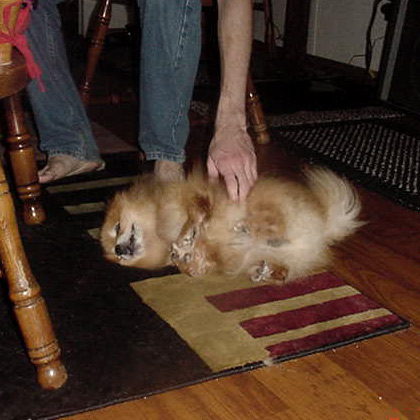
We also have our newest addition to the pack, our young, “bad boy†escape artist Leo. He jumps the fence out back and then runs around to the front door and barks to let us know he’s escaped…a fine example of ‘dog logic’! Leo is pictured here with Freeway and Baby, the cats who like to have him chew on their ears (we call these cats the slobberheads now.) Our other 2 cats, Ziggy and Elvis do NOT allow any ear chewing!
Yes, you read that right…we have four dogs and four cats. We rescued 4 of our critters in Houston and now have two cats and two dogs each. Ironically enough, our crazy cats also like the dog treats…like we said “catogs†and “docatsâ€!
They have all threatened mutiny should we ever stop baking our treats and while we’ve promised them we won’t, we offer a unique business opportunity for anyone who wants to start a large-scale dog treat business. Visit our Bonz Bakery website for more information on how you can save yourself hundreds of hours and many headaches in starting your own dog treat business!
We hope you’ll enjoy this blog which will be full of fun stuff, useful health tips, great dog videos and stories, dog pictures, articles, local dog events in Nashville and more!
I found this article by Jonni Good and while it is a sad commentary on the cruelty of whoever abandoned Hank (or poisoned him), publishing it may help save other dogs from inadvertent poisoning by owners who DO care and simply don’t know the dangers of common household products.
 Several months ago I adopted Hank, a five-year old mutt, from the local Humane Society. I had every hope that he would be a companion and playmate for Banjo, my Australian Shepherd. Unfortunately, things didn’t turn out the way I expected. All in all, it was a very bad day for me, for the local veterinarian, for the people at the animal shelter who had come to love quiet, mild-mannered Hank, and, of course, for Hank himself.
Several months ago I adopted Hank, a five-year old mutt, from the local Humane Society. I had every hope that he would be a companion and playmate for Banjo, my Australian Shepherd. Unfortunately, things didn’t turn out the way I expected. All in all, it was a very bad day for me, for the local veterinarian, for the people at the animal shelter who had come to love quiet, mild-mannered Hank, and, of course, for Hank himself.
The first inkling I had that something was very wrong with Hank came while walking him around the exercise yard at the shelter. Hank stopped to piddle so often that I remarked on it, but the shelter volunteer said it was common with animals that are locked in their pens for so long every day. A housebroken dog, she said, will “hold it†until he gets outside, and then the floodgates open. That sounded reasonable to me, so I filled out the adoption paperwork, handed over the fees, and took Hank out to my car, where I saw the second indication of severe illness. Hank actually fell into my small car. This lack of coordination seemed like a small problem, but it did put me on alert.
He and Banjo seemed to get on just fine when I introduced them at home, but Hank still wasn’t acting right. The floodgates were still open, and he couldn’t stay away from the water dish. His fur was falling out in great gobs, and something in Hanks eyes told me he just didn’t feel good. I called the local vet and asked for an emergency appointment.
To make a long story short, Hank had to be put down that afternoon after tests showed his kidneys were shutting down. The vet said it was most likely that Hank had been poisoned, probably with antifreeze, a sweet-tasting liquid that dogs find irresistible, but which can cause mental confusion, vomiting, kidney failure, and death. Hank would have lapped up the antifreeze before he was brought to the shelter, where he spent several weeks waiting for someone to take him home. If the shelter volunteers had been more observant, could they have saved Hank? Its possible, but well really never know.
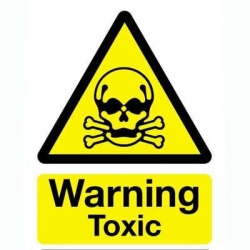 Unfortunately, antifreeze is not the only common household chemical that can cause serious illness in dogs. Since dogs are curious creatures, and some of these poisons taste good to both dogs and children, special caution should be taken to keep the following substances away from your pets. If you suspect that your dog has ingested any of these products, or if it shows any of the following signs of illness, he must be taken immediately to the nearest veterinary clinic.
Unfortunately, antifreeze is not the only common household chemical that can cause serious illness in dogs. Since dogs are curious creatures, and some of these poisons taste good to both dogs and children, special caution should be taken to keep the following substances away from your pets. If you suspect that your dog has ingested any of these products, or if it shows any of the following signs of illness, he must be taken immediately to the nearest veterinary clinic.
Antidepressant drugs, which can cause irregular heartbeat, vomiting hyperactivity, tremors and seizure.
Pesticides, such as flea and tick collars, sprays and powders; rat poisons; strychnine; and zinc phosphate. The symptoms of poisoning will vary, depending on the particular pesticide that was ingested. Symptoms can include vomiting, diarrhea, lack of balance or coordination, nosebleeds, internal bleeding through the gut or urinary track, difficulty breathing, listlessness, nervousness, seizures, and death. If your pet gets into one of these poisons, try to take the container with you to the vets office, so he or she can give the appropriate antidote and emergency treatment as quickly as possible.
Antifreeze, as noted earlier. Immediate veterinary treatment may be able to save your pet, from kidney failure if it is rushed to the animal clinic in time.
Ammonia, disinfectants, and fabric softener can cause vomiting, diarrhea and seizures. Call your pets veterinarian immediately – the clinic may suggest that you give the dog milk or water to dilute the poison before rushing it to the clinic.
Household bleach can cause excessive salivation (or slobbering), and vomiting. Again, call your vet immediately to see if you should try to dilute the poisons by giving your dog emergency care at home before rushing it to the clinic. Bleach can cause ulcerations to the stomach lining and gastrointestinal tract.
Lead from old paint, batteries, lead glazing on pottery, and bird shot may cause vomiting, constipation or diarrhea, muscle spasms, blindness, and personality changes. The dogs veterinarian will need to run some tests to see if lead is the cause of the illness, and may need to perform surgery if the item is still in the dogs stomach.
Petroleum products, like gasoline or other fuels, solvents, and paints, can poison a dog either through eating it, breathing it, (which can burn the lining of the lungs), or getting it on the skin. If one of these products gets on your dogs fur, immediately wash it off with water and detergent, and then get him to the vet. If the product has been ingested or if the dog has been breathing the fumes, medical care will be required to reduce the damage.
Less potent but still dangerous substances that can cause symptoms of poisoning in dogs are chocolate, caffeine, onions and garlic.
Jonni writes about dog adoption and dog health on her website at http://www.older-dog.com
 I’ve got my tail between my legs because I haven’t blogged in a whole MONTH! What’s worse, I haven’t finished updating the Bonz Bakery website either…baaaad dog!
I’ve got my tail between my legs because I haven’t blogged in a whole MONTH! What’s worse, I haven’t finished updating the Bonz Bakery website either…baaaad dog!
Forget that I’m updating ALL of my internet business sites AND I’m introducing a whole new service that requires a ton of research. Forget that we’re not doing any events or markets right now (winter break is a nice relief for us, I must admit.) Forget all those excuses…I’m just bein’ lazy! Not. But I DO feel guilty!
I barely sleep as it is and now, here I am, gearing up for the spring-summer season and recognizing that I’ve left our little blog alone for too long. Sigh, yep, I’m a bad, bad dog!Â
Sleep is a dog’s favorite thing by the way…well, besides love and pets, treats, love and scratches, going for walks and playing with toys! Oh, and Bonz Bakery All Natural Wheat Free Dog Treats (of course ![]() )
)
So, I’m back and I’ll try to blog more often…the tail between my legs is definitely uncomfortable.
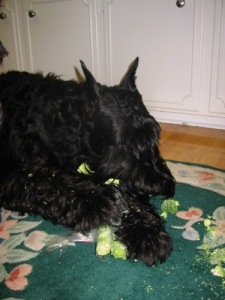 A large number of vegetarians and vegans are dog owners. As a result of their personal view and their own satisfactory dietary experiences, many then make the decision to adjust their dog’s diet so that it is comprised exclusively from plant sources.
A large number of vegetarians and vegans are dog owners. As a result of their personal view and their own satisfactory dietary experiences, many then make the decision to adjust their dog’s diet so that it is comprised exclusively from plant sources.Humans are omnivores. We are provided with saliva that contains various enzymes to predigest the starches in our diet, specific teeth to grind and breakdown the plant fibers we eat and a digestive tract of medium length. In addition, our jaws work in a manner that allows them to move not only in an up and down direction, but also from side to side, so we can easily eat foods derived from both plant and animal origins.
Dogs, on the other hand, are carnivorous. Unlike us, the jaws of dogs can only move up and down. Canine teeth are pointy and sharp, having evolved for tearing animal tissue, as opposed to the grinding of plant matter. Canine’s saliva does not contain enzymes for breaking down grainy foods and they have a digestive tract that is short, for easy digestion of animal proteins and fats.
Besides these basic physiological differences between dogs and humans, there are a number of other concerns the dog owner should be aware of if considering placing their pet on a vegetarian diet. We’ll touch on just a few of them here:
• If the owner’s concern is to ensure that their dog will not suffer from high cholesterol or heart disease as do humans whose diets are high in meat intake, they should be aware that dogs do not suffer from coronary disease or cholesterol problems at anywhere near the incidence humans do. So cutting out meat and dairy products from the dog’s diet may not provide any benefit.
• Dogs require a high amount of proteins, which are needed to support proper organ growth. Proteins are comprised of different amino acids. The best source of the required proteins is from animal sources. While there do exist some plant sources such as soy that contain high protein levels, the amino acids within soy are not as well-balanced as those derived from animals. Specifically, dogs require taurine and l-carnitine found in meat products. While one can add taurine and l-carnitine to a dog’s diets, this raises another concern. Animal sources hold more protein, gram for gram, than do starches, grains or vegetables. So in order for the dog to get the required amount of taurine and l-carnitine, they will have to ingest a much greater quantity of food daily, which can lead to obesity and other health problems.
• Another essential nutrient required by dogs for good health is vitamin B12, which is not found in most plants.
While theoretically a dog owner can supplement his pet’s diet with nutrients to overcome these dietary deficiencies, it can be expensive to do so. In addition, it is very difficult to monitor the amounts and the balance between the nutrients when they are inserted into an animal’s diet not through natural foods, but with supplementation.
So dog owners should carefully consider all issues before placing their pets on a purely non-animal based diet. Prior to changing their dog’s diet in such a fundamental manner, they should first consult with their veterinarian as well as thoroughly research the issue. Then, if they decide to go ahead, they should carefully monitor the dog’s health on a consistent basis and should any problems be observed, seek the advice of their veterinarian.
Michael Rupkalvis operates the TakeCareofYourPet website. The website features a product called Hope for Pets, a natural powder that he believes is the best natural supplement available today to aid in optimizing the health and longevity of our dogs.
In this article we’re going to discuss clicker training and its use in training dogs. Most people have heard of clicker training but have no clue what it actually is. In this article we’ll discuss what t is and how to start using it as well as just how powerful this training can be. Most dogs take to clicker training very easily and enjoy learning through the use of a clicker.
What Clicker Training Is
Clicker Training is a positive method of training a dog new behaviors.  This means there is no correction for the dog getting anything wrong, just reward for when it gets the new behavior right. Unlike some other dog training, clicker training does not rely on baiting where the dog is simply bribed into performing a certain behavior.
The problem with baiting is that its a very dependent on the owner and takes a lot time to become an independent behavior without many cues. As well as allowing you to teach your dog an independent behavior much quicker than with baiting or other conventional dog training, clicker training also allows your dog to learn at a fast rate because it’s being given much clearer instruction.
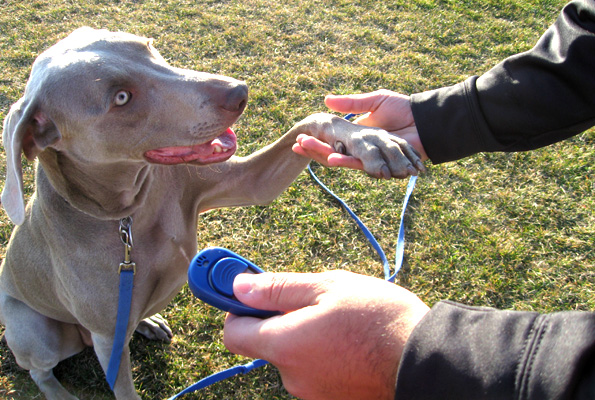
How Clicker Training Works
The principle behind clicker training is that the click noise given off by the clicker means correct. So the dog soon learns that the exact position it’s in, or the behavior it’s performing when the clicker goes off means that it is the correct position/behavior. When a dog gets used to clicker training, and is clear when it’s doing the correct behavior, new behaviors are formed very quickly.
The main things to consider when clicker training are rate of reinforcement, timing and motivation. Rate of reinforcement is all about how often your reward and how much of a reward you give. When first starting you should reward often and quickly. You need to reward as soon as the dog has performed the correct behavior because then the message “that’s right!†is crystal clear.
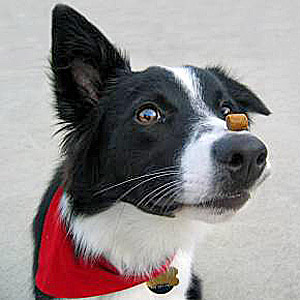 As your dog’s understanding increases, the rate of reinforcement can be decreased and your dog should be holding the correct behavior longer.  Timing is extremely important in any dog’s training; you must use the clicker the millisecond your dog performs the correct behavior. Clicker training is all about timing…the quicker you click and reward, the faster the dog will learn the new behavior.
As your dog’s understanding increases, the rate of reinforcement can be decreased and your dog should be holding the correct behavior longer.  Timing is extremely important in any dog’s training; you must use the clicker the millisecond your dog performs the correct behavior. Clicker training is all about timing…the quicker you click and reward, the faster the dog will learn the new behavior.
The next major thing to consider is motivation. Without motivation you have nothing as a dog must love to work (and it’s one hundred percent the trainer’s responsibility to make a dog love working!) There are many ways to motivate a dog these include treats, toys, attention and play. Always keep your training short and fun, ten to fifteen minutes at a time is perfect. Any more than this and the dog will get fed up. Remember that you should always finish training when your dog is alert and still enjoying the training! Never finish when your dog is bored and unmotivated as this produces nothing except a dog who doesn’t enjoy working.
How To Get Started Clicker Training
To get started clicker training all you need is a clicker, a reward and a willing dog.  Experiment and have fun, it’s the best way to learn about clicker training and training dogs in general. There’s no substitute to a good working relationship with your dog; you’ll find training much easier when you develop that relationship because you’ll know how your dog is going to react to everything you do, and they’ll know what’s expected of them and perform accordingly.
A gazillion and one people have seen this video but we wanted to show it to those who have not. Rookie has gone over the Rainbow Bridge but he’ll always be loved and I smile every time I watch this video! His love of his owner, Carolyn Scott, is so obvious and this special golden retriever reminds me of how much dogs love us and how willing they are to please us…how can we do less for them?
 We thought a great way to start the New Year is to post a video of two of our favorite dance routines with Rookie and Carolyn. Enjoy! (Make sure your sound is turned on or this movie will not be nearly as fun to watch.)


No comments:
Post a Comment